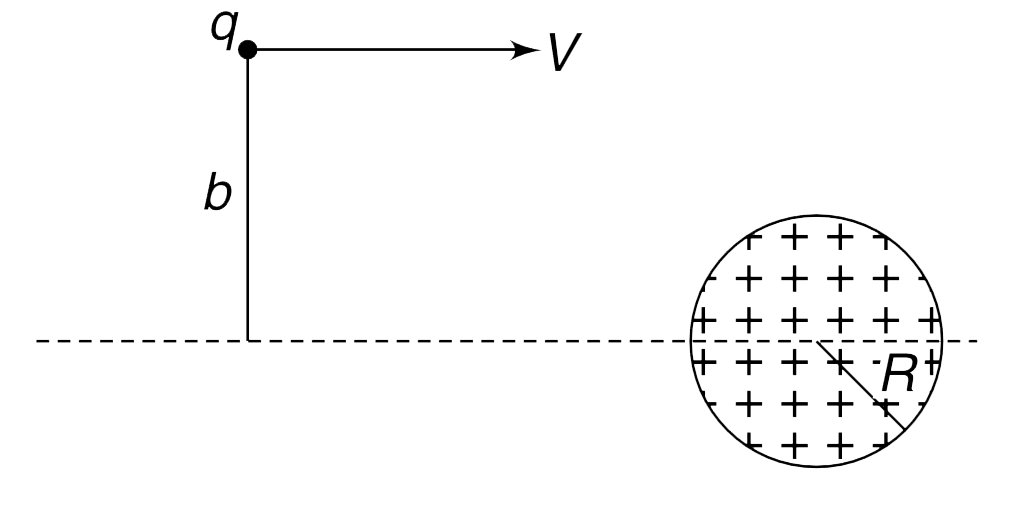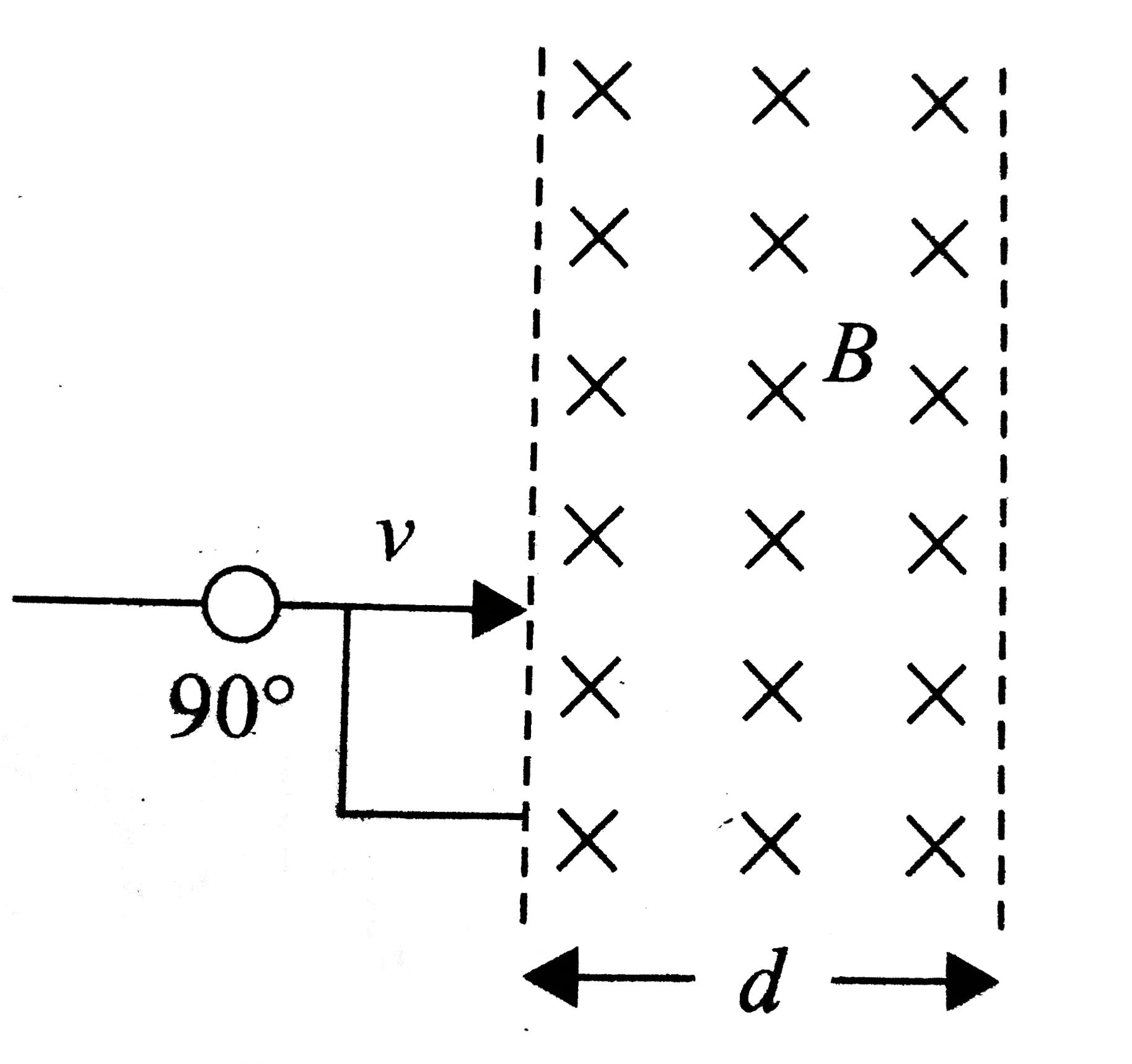A particle of mass m and charge q is projected into a region having a uniform magnetic field B0. Initial velocity (v0) of the particle is perpendicular to the magnetic field. Apart from the magnetic force the particle faces a frictional force which has a magnitude of f = kv where v is instanta- neous speed and k is a positive constant.
(a) Find the radius of curvature of the path of the particle after it has travelled through a distance of
x0=mv02K.
(b) Plot the variation of radius of curvature of the path of the particle with time (t).
The correct Answer is:(a)mv2qB0
(##IJAPHYV02C09E01020_Q01##)
Step by step video, text & image solution for A particle of mass m and charge q is projected into a region having a uniform magnetic field B0. Initial velocity (v0) of the particle is perpendicular to the magnetic field. Apart from the magnetic force the particle faces a frictional force which has a magnitude of f = kv where v is instanta- neous speed and k is a positive constant. (a) Find the radius of curvature of the path of the particle after it has travelled through a distance of x_(0)=(mv_(0))/(2K). (b) Plot the variation of radius of curvature of the path of the particle with time (t). by Physics experts to help you in doubts & scoring excellent marks in Class 12 exams.
Topper's Solved these Questions
- BOOK - ARIHANTCHAPTER - MOTION OF CHARGE IN MAGNETIC FIELDEXERCISE - Level-34videos
MOTION OF CHARGE IN MAGNETIC FIELD
- BOOK - ARIHANTCHAPTER - MOTION OF CHARGE IN MAGNETIC FIELDEXERCISE - Level-34videos
MOTION OF CHARGE IN MAGNETIC FIELD
- BOOK - ARIHANTCHAPTER - MAGNETIC EFFECT OF CURRENTEXERCISE - Magnetic effect of Current45videos
MAGNETIC EFFECT OF CURRENT
- BOOK - ARIHANTCHAPTER - NUCLEAR PHYSICSEXERCISE - All Questions54videos
NUCLEAR PHYSICS
Similar Questions
There is a fixed sphere of radius R having positive charge Q uniformly spread in its volume. A small particle having mass m and negative charge (–q) moves with speed V when it is far away from the sphere. The impact parameter (i.e., distance between the centre of the sphere and line of initial velocity of the particle) is b. As the particle passes by the sphere, its path gets deflected due to electrostatics interaction with the sphere.
(a) Assuming that the charge on the particle does not cause any effect on distribution of charge on the sphere, calculate the minimum impact parameter b0 that allows the particle to miss the sphere. Write the value of b0 in term of R for the case
12mV2=100.(kQqR)
(b) Now assume that the positively charged sphere moves with speed V through a space which is filled with small particles of mass m and charge – q. The small particles are at rest and their number density is n [i.e., number of particles per unit volume of space is n].
The particles hit the sphere and stick to it. Calculate the rate at which the sphere starts losing its positive charge dQdt. Express your answer in terms of b0
 04:26View Solution
04:26View SolutionThere is a fixed sphere of radius R having positive charge Q uniformly spread in its volume. A small particle having mass m and negative charge (–q) moves with speed V when it is far away from the sphere. The impact parameter (i.e., distance between the centre of the sphere and line of initial velocity of the particle) is b. As the particle passes by the sphere, its path gets deflected due to electrostatics interaction with the sphere.
(a) Assuming that the charge on the particle does not cause any effect on distribution of charge on the sphere, calculate the minimum impact parameter b0 that allows the particle to miss the sphere. Write the value of b0 in term of R for the case
12mV2=100.(kQqR)
(b) Now assume that the positively charged sphere moves with speed V through a space which is filled with small particles of mass m and charge – q. The small particles are at rest and their number density is n [i.e., number of particles per unit volume of space is n].
The particles hit the sphere and stick to it. Calculate the rate at which the sphere starts losing its positive charge dQdt. Express your answer in terms of b0
 01:09View Solution
01:09View SolutionSketch the magnetic field lines in xy plane for a pair of long parallel wires laid along z direction if-
(a) Both wires carry current in same direction.
(b) Both wire carry current in opposite directions.01:00View SolutionAssume that an electron and a position pair is formed from a gamma ray photon having energy 3.0 MeV. Find the total kinetic energy of the positron and the electron that is formed.
View SolutionA positive charge particle of mass m and charge q is projected with velocity v as shown in Fig. If radius of curvature of charge particle in magnetic field region is greater than d, then find the time spent by the charge particle in magnetic field.
 04:21View Solution
04:21View SolutionA charged particle moves with velocity v in a uniform magnetic field vecB . The magnetic force experienced by the particle is
01:53View SolutionMagnetic force acting on the charged particle projected perpendicular to magnetic field is proportional to vn. Where v is the speed. Find n
02:31View SolutionA positive charge particle of charge q, mass m enters into a uniform magnetic field with velocity v as shown in the figure. There is no magnetic field to the left of PQ. Find impulse of magnetic force.
04:25View Solutionद्रव्यमान m व आवेश q का एक कण एक समान चुम्बकीय क्षेत्र में v वेग से क्षेत्र की दिशा के लम्बवत् प्रवेश करता है। कण का घूर्णन काल
02:27View SolutionA particle having charge q moves with a velocity v through a region in which both an electric field →E and a magnetic field B are present. The force on the particle is
53:40View SolutionA charged particle of mass m and charge 'q' is projected with a velocity vec V into uniform magnetic field of induction vec B . The force experienced by the charged particle is
53:40View SolutionA positive charge particle of mass m and charge q is projected with velocity v as shown in Fig. If radius of curvature of charge particle in magnetic field region is greater than d, then find the time spent by the charge particle in magnetic field.
 01:36View Solution
01:36View SolutionAssertion When a charged particle moves perpendicular to a uniform magnetic field then its momentum remains constant.
Reason Magnetic force acts perpendicular to the velocity of the particle.01:16View SolutionMagnetic Force on Charge||Path OF Charge Particle Moving Perpendicular to Magnetic Field||Charge Particle Moving Along Magnetic Field
03:56View SolutionMagnetic Force on Charge||Path of Charged Particle Moving Perpendicular to Magnetic Field||Charged Particle Moving Along Magnetic Field
View Solution

